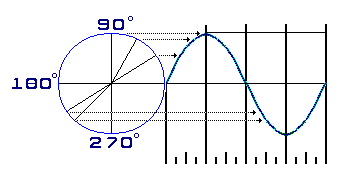
Introduction
Chapter 1 - Electricity
Chapter 1.2 - The Numbers
Chapter 2 Sharing and Bonding
Chapter 3 - Voltage
Chapter 3.2 Voltage Static
Chapter 3.3 - Batteries
Chapter 3.4 Solar - Others
Chapter 4 - Resistance
Chapter 4.2 Parallel Resistance
Chapter 4.3 Voltage Dividers
Chapter 5 - Semiconductor
Chapter 5.2 - PNP NPN Junctions
Chapter 6 AC and Hertz
Chapter 7 - Magnetism
Chapter 7.2 - Inductors
Chapter 8 - Capacitor
Chapter 9 - IC's and Amplifier
Chapter 10 - 555 Timer
Chapter 11 - Logic
Chapter 12 - Power Supply
|
|
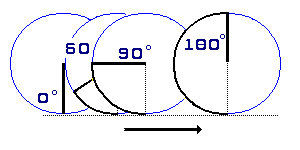 As the bicycle moves forward the wheel rotates 60, 90, 180 and at some time a full 360 degrees.
Keep the speed steady for example 15 degrees of rotation every 5 seconds.
Every 5 to 10 seconds place a mark on the wheel where it is touching the road. ONE bicycle wheel rotation (1-cycle) over ONE time. In this
example the wheel is turning clockwise and moving forward in time and in distance.
As the bicycle moves forward the wheel rotates 60, 90, 180 and at some time a full 360 degrees.
Keep the speed steady for example 15 degrees of rotation every 5 seconds.
Every 5 to 10 seconds place a mark on the wheel where it is touching the road. ONE bicycle wheel rotation (1-cycle) over ONE time. In this
example the wheel is turning clockwise and moving forward in time and in distance. 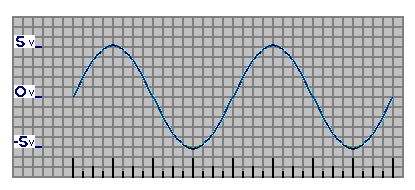 time of 750 ms and then returns back to 0.0 volts at the 1 second mark.
This is one cycle. The entire process then repeats for a additional cycle.
time of 750 ms and then returns back to 0.0 volts at the 1 second mark.
This is one cycle. The entire process then repeats for a additional cycle.
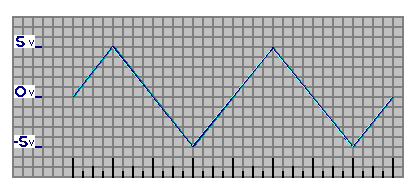 Next, take a look at the saw tooth wave pattern. It is similar to the
sign wave, with the notable difference that the voltage changes linearly
over time. This oscilloscope image displays two full time cycles for the
saw tooth wave form. This is also a 10-volt peak-to-peak display with one
cycle over 1 second or 1 Hz.
Next, take a look at the saw tooth wave pattern. It is similar to the
sign wave, with the notable difference that the voltage changes linearly
over time. This oscilloscope image displays two full time cycles for the
saw tooth wave form. This is also a 10-volt peak-to-peak display with one
cycle over 1 second or 1 Hz.
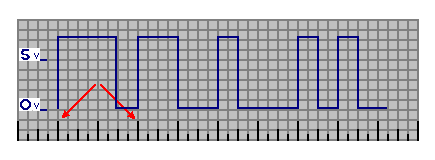 This next oscilloscope display is a Square Wave pattern. There are 4 time
cycles with each one being 1 second. With each second in time, the voltage pattern
is different.
This next oscilloscope display is a Square Wave pattern. There are 4 time
cycles with each one being 1 second. With each second in time, the voltage pattern
is different. 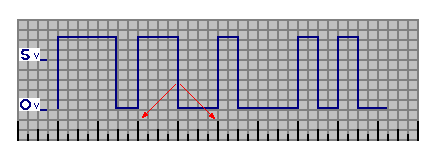 The this graph the 2nd time interval, as marked by red arrows, is also one second in duration.
The voltage peak is fully on at 7.2 V for half of a cycle and fully off
for the other half of a second..
The this graph the 2nd time interval, as marked by red arrows, is also one second in duration.
The voltage peak is fully on at 7.2 V for half of a cycle and fully off
for the other half of a second..
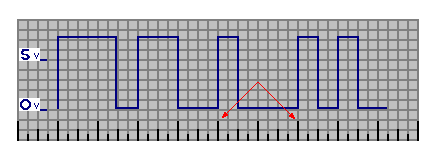 The 3rd time interval, also marked with red arrows, is also one second in duration.
This voltage is on for only one forth of the period at 7.2V then is
0 V for three-quarters of the time.
The 3rd time interval, also marked with red arrows, is also one second in duration.
This voltage is on for only one forth of the period at 7.2V then is
0 V for three-quarters of the time.
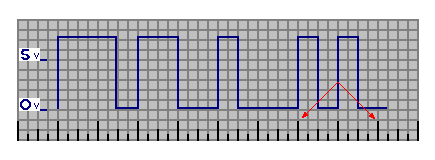 In the 4th time interval of one second in duration, the 7.2 V pulse in present for
the first-quarter of the time,
off for the second-quarter, present for the third-quarter and off for the
forth.
In the 4th time interval of one second in duration, the 7.2 V pulse in present for
the first-quarter of the time,
off for the second-quarter, present for the third-quarter and off for the
forth.